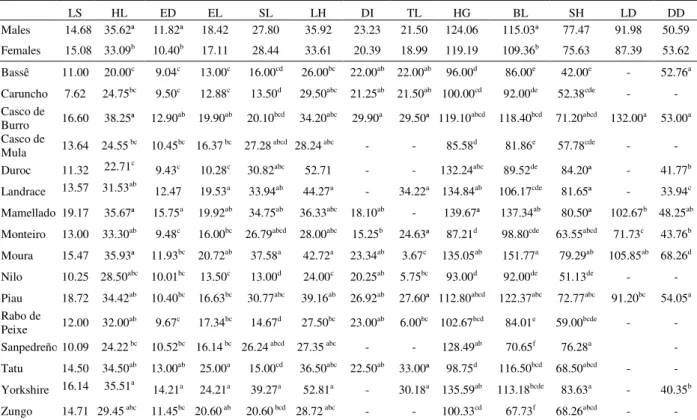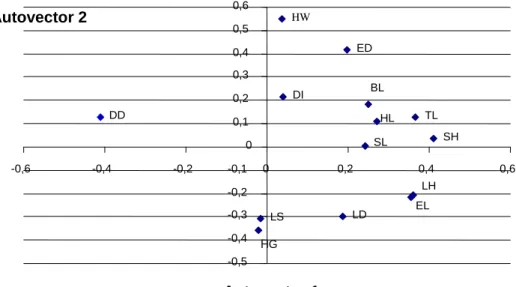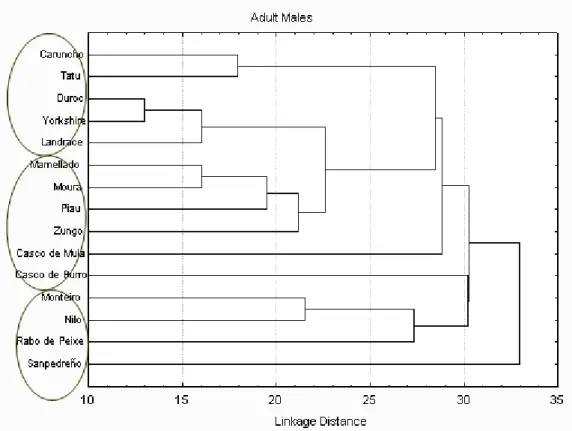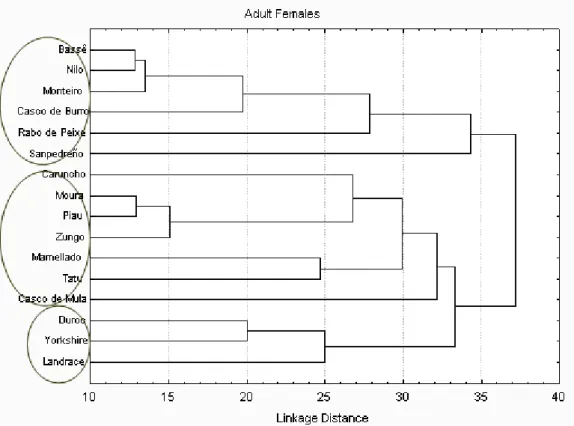Vol.53, n. 3: pp.583-591, May-June 2010
ISSN 1516-8913 Printed in Brazil BRAZILIAN ARCHIVES OF
BIOLOGY AND TECHNOLOGY
A N I N T E R N A T I O N A L J O U R N A L
Phenotypic Characterization of Naturalized Swine Breeds in
Brazil, Uruguay and Colombia
Concepta McManus
1*, Samuel Rezende Paiva
2, Alva Vanessa Rezende Silva
1, Luci Sayori
Murata
1, Helder Louvandini
1, Glória Patrícia Barrera Cubillos
3, Gustavo Castro
4, Rodrigo
Alfredo Martinez
3, Maria Sílvia Llambi Dellacasa
4and Juan Esteban Perez
31
Faculdade de Agronomia e Medicina Veterinária; Universidade de Brasília; 70910-900; Brasília - DF - Brasil. 2Embrapa Recursos Genéticos e Biotecnologia; Final W5 Norte; 70771-900, Brasília - DF - Brasil. 3Corporación
Colombiana de Investigación Agropecuária; Km. 14, Vía Mosquera; Bogotá – Colômbia. 4Luis A. de Herrera 1503/1003; CP 11.600; Montevideo – Uruguay
ABSTRACT
Morphometric data was collected on 859 naturalized swine in Brazil (Piau, Tatu, Nilo, Caruncho, Casco de Burro, Moura, Monteiro and Rabo de Peixe), Colombia (Criolla Zungo, Sanpedreño and Casco de Mula) and Uruguay (Mamellado), both on farm and in published material. Information was collected on breed, sex and age, as well as various morphometric measurements. Analysis of variance was carried out using PROC MIXED of SAS ® on phenotypic data. The coefficients of variance varied between 11.50 and 83.81%, and the coefficient of determination was medium to high. Females were in general smaller for most measurements than males, showing sexual dimorphism. The Moura was the closest naturalized breed to the commercial breeds, followed by the Piau, while the Monteiro was the furtherest. The dendrogram obtained from morphological information showed a division of the pigs into three groups. Characterization was possible using morphological and morphometric data.
Key words: Measures, morphology, morphometric, phenotypic distance
*Autor for correspondence: concepta@unb.br
INTRODUCTION
Naturalized swine breeds found in Brazil and other Latin American countries, also known as crioula breeds, are originated from those brought by the Portuguese and Spanish settlers during the 16th century. According to Mariante and Cavalcante (2000), these breeds underwent natural selection to
acquire adaptive traits in specific local
environments over time. Some naturalized breeds, although they have different names in different
1930s and 1970s for study and selection, but at present little is known about the geographic distribution, representativity, economic importance and production of naturalized swine breeds. Crossbreeding and selection can rapidly modify characteristics of a breed, giving rise to different genetic groups, complicating breed identification. Although molecular techniques have aided in the identification and characterization of individuals
and breeds, phenotypic and production
characterization is also necessary. Therefore, the use of breed standardization, definition of unique traits and determination of risk to which a breed is subjected is useful to better know the breeds in question (Rothschild, 2003). The conservation and improvement of naturalized breeds is justified as they may contain a pool of genetic material for maintenance and improvement of specific traits in the commercial population, especially in terms of heat and parasite resistance (Notter, 1998). Egito et al. (2002) noted that the in depth study of breeds may facilitate the development and rational control of future breeding programs, as well as the preservation and conservation of germplasm. The systematic understanding of pig breeding implies that knowledge of the historical basis which gives foundation to the origin and evolution of breeds is necessary. The similarity and differences between commercial and native breeds is important to identify and evaluate their origins and possible sources of genes for genetic improvement of herds. Animal size is also necessary to determine feeding regimes and housing requirements (Anil et al., 2002). Space allocation is one also an important variable for farm animals and has a direct affect on the welfare of farm livestock (Pastorelli et al., 2006). Insufficient space allocation for pigs in confinement has been shown to affect growth and productive performance, and may affect animal health (Gonyou and Stricklin, 1998; Spoolder et al., 2000). Body measurements are also used to determine weight when no weighing scales are available, which is frequently the case with naturalized breeds (Lawrence and Fowler, 1997). Few studies have been carried out on the diversity of naturalized swine breeds in South American countries. Subjective data is frequently missing for most naturalized breeds of farm animals (FAO, 1999). Knowledge about the
genetic, morphological and productive
characteristics of the breed as well as about its products is essential in order to set up a rational production system (Pietrolà et al., 2006). This
study aimed to phenotypically characterize naturalized swine breeds in Brazil, Uruguay and Colombia and compare breed distances using morphometic and size data.
MATERIALS AND METHODS
Data was collected on 859 (59% female and 41% male) naturalized adult pigs in Brazil, Uruguay and Colombia. Data was also available from literature. The Brazilian breeds studied were Piau, Tatu, Nilo, Caruncho, Casco de Burro (Mulefoot), Moura, Monteiro and Rabo de Peixe (Fishtail). From Colombia data was available on the Criolla Zungo, Sanpedreño and Casco de Mula breeds, while the Mamellado breed was studied in Uruguay. Commercial herds included in this study were Landrace, Large White, Yorkshire and Duroc. The herds were selected due to their population size, breed purity and lack of
inbreeding between herds to obtain a
representative sample of the breeds. In Brazil, data were collected in Minas Gerais, Santa Catarina, Mato Grosso do Sul and Bahia states as well as the Federal District. Data from Colombia and Uruguay were collected near Bogotá and Montevideo, respectively. Data collection was standardized in meetings held at the beginning of the experiment. Since data were collected by different people in the three countries there may be an effect of technician but this was not included in the model as it was confounded with country. Phenotypic characterization included information on breed, sex, age, body length (BL), dorso-sternal distance (DD), ear length (EL), head length (HL), heart girth (HG), interisquiatic distance (DI), interorbital distance (ID), length of hip (LH), longitudinal distance (LD), shoulder height (SH), shoulder length (SL), snout length (SL), tail length (TL).
All animals were measured standing
Phenotypic data were analysed using simple descriptive measures (mean, standard deviation) and meta-analysis using PROC MIXED of SAS (1999). Distances between breeds were carried out using morphology and measurements by sex, calculating dissimilarity and distance using
UPGMA (Unweighted Pair Group Method Arithmetic Mean) to generate the dendrogram. Only adult animals were considered. The statistical analysis programs GENES ® and STATISTICA ® were used to evaluate population structure.
Table 1 - Traits of morphological measurements realized with naturalized and commercial swine breeds in Brazil, Colombia and Uruguay.
Trait Description
Body length (BL) Distance from the external occipital protuberance to the base of the tail on the dorsal line; distance between tip of scapula and ischium, measured as the distance between the point of shoulder and the pin bone.
Dorso-sternal distance (DD) From the point of the shoulder to the sternum; distance between dorso and sternum
Eye distance (ED) Inter orbital distance
Ear length (EL) From central point of the base to the vertix; from the base of the notch to the most distant point of the margin of the pinna (external ear)
Head length (HL) From the external occipital protuberance occipital to tip of nasal bone
Heart girth (HG) Total distance around the animal (circumference) measured directly behind the front leg; total distance around the animal (circumference) measured directly behind the front leg;
Interisquiatic distance (DI) Distance between external point of both isquial bones
Interorbital distance (ID) Between both frontal sigmoid apophysis; distance between left and right endocanthion;
Length of hip (LH) From the external iliac tuberosity to the point of the pin bone; from the external angle of the ileum to the isquiatic tuberosity
Longitudinal distance (LD) From point of the shoulder to the point of the pin bone
Shoulder height (SH) Distance from the surface of a platform to the top of the shoulder
Shoulder length (SL) From the superior border of the scapula to the carpus
Snout length (SL) Tip of the nasal bone to coronal suture; From the frontal-nasal suture to the point of the snout
Tail length (TL) From insertion of the tail to the tail tip
RESULTS AND DISCUSSION
Sex significantly influenced the morphometric measurements, except for snout length, shoulder length, longitudinal distance and dorso-sternal distance. All morphological traits were influenced by breed, except snout length. The variation coefficient (Table 2) varied between 11.50 and 83.81%, indicating phenotypic variation among individuals. Since different breeds have specific traits such as snout or ear length, these variations are to be expected. The determination coefficient was medium to high varying between 0.06 for snout length to 0.70 tail length. No significant
Table 2 - Summary of variance analysis for body measurements (cm) in swine in South America.
LS HL ED EL SL LH DI TL HG BL SH LD DD
Breed NS *** *** *** *** *** *** *** *** *** *** *** ***
Sex NS ** *** * NS ** ** * ** ** *** NS NS
R² 0.06 0.39 0.68 0.55 0.57 0.56 0.50 0.70 0.66 0.69 0.55 0.58 0.29 CV 83.81 12.53 11.50 13.96 23.30 18.03 25.80 35.30 12.25 12.07 12.26 15.50 29.96 Mean 14.96 33.80 10.78 17.47 28.25 34.25 21.17 19.66 120.33 110.70 75.31 88.40 52.95 NS = not significant; *** P < 0,001; ** P < 0,01; * P < 0,05, R2 = determination coefficient; CV = variation coefficient; Snout Length (LS); Head Length (HL); Eye distance (ED); Ear Length (EL); Shoulder Length (SL); Hip length (HL); Distance between isquias (DI); Tail Length (TL); Heart Girth (HG), Body Length (BL); Shoulder Height (SH); Longitudinal distance (LD); Dorso-sternal distance (DD).
Table 3 - Corrected means for body measurements in naturalized and commercial pigs from Brazil, Colombia and Uruguay.
LS HL ED EL SL LH DI TL HG BL SH LD DD
Males 14.68 35.62ª 11.82ª 18.42 27.80 35.92 23.23 21.50 124.06 115.03ª 77.47 91.98 50.59
Females 15.08 33.09b 10.40b 17.11 28.44 33.61 20.39 18.99 119.19 109.36b 75.63 87.39 53.62
Bassê 11.00 20.00c 9.04c 13.00c 16.00cd 26.00bc 22.00ab 22.00ab 96.00d 86.00e 42.00e - 52.76a
Caruncho 7.62 24.75bc 9.50c 12.88c 13.50d 29.50abc 21.25ab 21.50ab 100.00cd 92.00de 52.38cde - -
Casco de
Burro 16.60 38.25ª 12.90
ab 19.90ab 20.10bcd 34.20abc 29.90a 29.50ª 119.10abcd 118.40bcd 71.20abcd 132.00a 53.00a
Casco de
Mula 13.64 24.55
bc 10.45bc 16.37 bc 27.28 abcd 28.24 abc - - 85.58d 81.86e 57.78cde - -
Duroc 11.32 22.71c 9.43c 10.28c 30.82abc 52.71 - - 132.24abc 89.52de 84.20ª - 41.77b
Landrace 13.57 31.53ab 12.47 19.53a 33.94ab 44.27a - 34.22a 134.84ab 106.17cde 81.65ª - 33.94c
Mamellado 19.17 35.67ª 15.75a 19.92ab 34.75ab 36.33abc 18.10ab - 139.67ª 137.34ab 80.50ª 102.67b 48.25ab
Monteiro 13.00 33.30ab 9.48c 16.00bc 26.79abcd 28.00abc 15.25b 24.63ª 87.21d 98.80cde 63.55abcd 71.73c 43.76b
Moura 15.47 35.93ª 11.93bc 20.72ab 37.58a 42.72a 23.34ab 3.67c 135.05ab 151.77a 79.29ab 105.85ab 68.26d
Nilo 10.25 28.50abc 10.01bc 13.50c 13.00d 24.00c 20.25ab 5.75bc 93.00d 92.00de 51.13de - -
Piau 18.72 34.42ab 10.40bc 16.63bc 30.77abc 39.16ab 26.92ab 27.60ª 112.80abcd 122.37abc 72.77abc 91.20bc 54.05a
Rabo de
Peixe 12.00 32.00
ab 9.67c 17.34bc 14.67d 27.50bc 23.00ab 6.00bc 102.67bcd 84.01e 59.00bcde - -
Sanpedreño 10.09 24.22 bc 10.52bc 16.14 bc 26.24 abcd 27.35 abc - - 128.49ab 70.65f 76.28a -
Tatu 14.50 34.50ab 13.00ab 25.00a 15.00cd 36.50abc 22.50ab 33.00ª 98.75d 116.50bcd 68.50abcd - -
Yorkshire 16.14 35.51a 14.21a 24.21a 39.27a 52.81a - 30.18a 135.59ab 113.18bcde 83.63a - 40.35b
Zungo 14.71 29.45 abc 11.45bc 20.60 ab 20.60 bcd 28.72 abc - - 100.33cd 67.73f 68.26abcd - - a, b, c,d, e
Means followed by different letters within the same column differ (P < 0,05) by Tukey Test. Snout Length (LS); Head Length (HL); Eye distance (ED); Ear Length (EL); Shoulder Length (SL); Hip length (LH); Distance between isquias (DI); Tail Length (TL); Heart Girth (HG), Body Length (BL); Shoulder Height (SH); Longitudinal distance (LD); Dorso-sternal distance (DD).
The Uruguayan breed Mamellado was as large as the commercial breeds for hearth girth and shoulder height and larger than the mean for other traits. Casco de Burro, Moura and Piau were also shown to be large naturalized breeds. The Moura breed was the naturalized Brazilian breed which was closest in shoulder height to the commercial breeds, followed by the Piau. These measurements for the two breeds in question were not significantly different (P>0.05). Their genetic proximity would need to be confirmed by molecular studies. This was probably due to the
studying naturalized cattle breeds. These differences are probably due to the fact that head traits are strongly related to breed while body traits
are strongly influenced by the environment, depending on feeding regime and rearing system.
Table 4 - Correlations between body measurements in naturalized pigs in Brazil, Uruguay and Colombia.
LS HL ED EL TL HG BL SH LD DD SL LH
HL 0.23 . . . .
ED -0.13 0.39 . . . .
EL 0.09 0.46 0.53 . . . .
TL 0.11 0.51 0.39 0.47 . . . .
HG 0.19 0.44 0.50 0.53 0.30 . . . .
BL 0.25 0.51 0.54 0.61 0.56 0.87 . . . .
SH 0.22 0.67 0.48 0.59 0.51 0.77 0.83 . . . . .
LD 0.17 0.25 0.53 0.53 0.45 0.83 0.83 0.72 . . . .
DD 0.07 0.13 0.29 0.46 0.09 0.66 0.64 0.56 0.60 . . .
SL 0.25 0.44 0.18 0.33 0.30 0.60 0.72 0.76 0.71 0.47 . . LH 0.19 0.45 0.47 0.50 0.37 0.86 0.87 0.78 0.79 0.66 0.65 DI 0.17 0.41 0.51 0.40 0.30 0.74 0.61 0.54 0.73 0.60 0.17 0.67 Snout Length (LS); Head Length (HL); Eye distance (ED); Ear Length (EL); Shoulder Length (SL); Hip length (LH); Distance between isquias (DI); Tail Length (TL); Heart Girth (HG), Body Length (BL); Shoulder Height (SH); Longitudinal distance (LD); Dorso-sternal distance (DD); Rib Width (BD).
The first two autovectors (Fig. 1) explained 49% of all variation between the traits measured. The first showed that an animal large for one trait was generally large for all, except dorso-sternal distance, in accordance with studies in other species (Miserani et al., 2002; McManus et al., 2005). The second described a sub group of animals with wide hips and small thoracic
perimeter. The naturalized Brazilian Caruncho breed and commercial Landrace were seen to be further apart (Figs. 2 and 3) for male and female adults respectively. The Caruncho is a small, dark skinned, very rustic, lard type animal while the Landrace is a white skinned, long meat producing animal (Cavalvanti, 2000).
Figure 1 - Autovectors traits of commercial and naturalized pig size from Brazil, Uruguay e Colombia. Snout Length (LS); Head Length (HL); Eye distance (ED); Ear Length (EL); Shoulder Length (SL); Hip length (LH); Hip width (HW), Distance between isquias (DI); Tail Length (TL); Heart Girth (HG), Body Length (BL); Shoulder Height (SH); Longitudinal distance (LD); Dorso-sternal distance (DD); Rib Width (BD).
EL LH
HL TL
SL SH
LD LS
HG
BL DI
ED HW
DD
-0,5 -0,4 -0,3 -0,2 -0,1 0 0,1 0,2 0,3 0,4 0,5 0,6
-0,6 -0,4 -0,2 0 0,2 0,4 0,6
Figure 2 (adult males) showed that large bodied animals were separated from small bodied ones, forming two groups. Although the Mamellado breed had some high morphometric measures such as thoracic perimeter and body length, this breed was classified in the smaller group according with dendogram, as most parameters grouped this breed with the smaller breeds. Comparing Figures 2 and 3, the latter (females) showed better group
definition for breeds. This may be explained by the fact that more females were sampled than males. Figure 3 showed three principal groups of swine. The first of small naturalized breeds, second large naturalized breeds and the third large commercial animals. In the second group, the Moura and Piau breeds were closely related, in agreement with that found in Table 2.
Figure 2 - Dendogram UPGMA based on distances between adult swine breeds using morphometric measures.
Figure 4 shows the division of breeds due to morphological traits. Three main groups were separated. The naturalized Brazilian breeds in the first group, which included the Bassê, Nilo and Tatu breeds, all have dark skin, lack hair and have a pendulous abdomen, characteristic of lard producers (Cavalcanti, 2000). The Marmellado (Uruguayan breed) was classified together with the commercial breeds, maybe indicating more recent crossbreeding, while the Zungo (Colombian breed) was closer to the larger naturalized Brazilian breeds. The commercial breeds (Duroc, Landrace, Large White, Yorkshire) were all selected for meat production while the Casco de Burro and Mamellado showed common traits such as straight
Figure 3 - Dendrogram UPGMA based on distances between adult female swine using morphological measurements.
CONCLUSION
Morphometric and morphology analyses may be useful in breed comparisons. These results were comparable to those from genetic marker studies. Breed distances varied depending on the data used but in general three groups were identified, small naturalized breeds, large naturalized breeds and commercial breeds. Much data is still lacking for naturalized breeds.
ACKNOWLEDGEMENTS
The authors wish to thank CNPq for scholarships and financial aid (Prosul), including INCT-IGSPB, as well as the farmers and researchers who contributed with data and access to the animals.
RESUMO
Foram colhidos dados morfométricos de 859 suínos naturalizados do Brasil (Piau, Tatu, Nilo, Caruncho, Casco de Burro, Moura, Monteiro e Rabo de Peixe), Colômbia (Criolla Zungo, Sanpedreño e Casco de Mula) e Uruguai (Mamellado) Dados sobre raça, sexo e idade foram
coletados, assim como varias avaliações
morfométricas. A análise de variância foi realizada utilizando-se o procedimento PROC GLM do SAS sobre os dados morfométricos. Os coeficientes de variância oscilaram de 11,50 a 83,81% e o coeficiente de determinação foi de moderado a alto. As fêmeas foram em geral menores na maioria das avaliações em relação aos machos, indicando dimorfismo sexual. A Moura foi a raça naturalizada mais próxima das raças comerciais, seguida da Piau, enquanto a Monteiro apresentou-se mais distante. O dendograma obtido a partir de informações morfológicas apresentou divisão dentro de três grupos. A caracterização foi possível utilizando-se dados morfológicos e morfométricos.
REFERENCES
Anil, L., Anil, S.S., Deen, J. (2002) Evaluation of the relationship between injuries and size of gestation stalls relative to size of sows. 221:834-836
Bermejo, J.V.D. (2004), Biodiversidad Porcina Iberoamericana: Caracterización y uso sustentable. 1. ed. Córdoba, 329p.
Cavalcanti, S.S. (2000), Suinocultura Dinâmica. 2. ed. Contagem: FEP – MVZ Editora, 494p.
Egito, A.A; Mariante A.S.; Albuquerque M.S.M. (2002), Programa Brasileiro de Conservação de Recursos Genéticos Animais. Arch. de Zootecnia. Córdoba. 51, 39-52.
FAO (1999), Primary Guidelines for Development of Nation Farm Animal Genetic Resource Management Plants. http://www.fao.org/dad-is. Acessed in 2004/03/12.
Garcia, S.K.; Barbosa, A.S. (2005), Conservação e Estudo de raças suínas brasileiras na UFMG – 12 anos. Escola de Veterinária. Belo Horizonte, pp 295-297.
Gonyou, H.W, Stricklin, W.R. (1998), Effects of floor area allowance and group size on the productivity of growing/finishing pigs, J. Anim. Sci.76, 1326–1330. Lawrence, T.L., Fowler, V.R. (1997), Growth of Farm
Animals. CAB International, Wallingford, Oxon, UK, p. 330
Mariante A.S.; Cavalacante, N. (2000) Animais do Descobrimento: Raças domésticas da história do Brasil. Embrapa Recursos Genéticos e Biotecnologia. 1ª Ed. Brasília - DF. 2000.
Mariante A.S.; Egito, A.A. (2002), Animal Genetic Resources in Brazil: result of five centuries of natural selection. Theriogenology, 233-235. 2002.
McManus, C.M.; Falcão, R.A.; Spritze, A.; Costa, D.; Louvandini, H.; Dias, L.T.; Teixeira, R.A.; Rezende, M.J.M.; Garcia, J.A.S. (2005), Caracterização morfológica de Eqüinos da Raça Campeiro. Rev. Bras. de Zootecnia, 34, 1553-1562.
Miserani, M.; McManus, C.M.; Mariante A.S.; Abreu, U.G.P.; Santos, S.A.; Silva, J. (2002), Variance analyses for biometric measures of the Pantaneiro horse in Brazil. Arch. de Zootecnia, Córdoba, 51, 113-121.
Notter, D.R. (1998), The importance of genetic diversity in livestock populations of the future. J. Anim. Sci. 77, 61-69.
Oliveira, E.M.B.; McManus, C.M.; Lucci, C.M.; Fernandes, M.C.B.; Prescott, E.; Mariante A.S.; Egito, A.A. (2006), Características corporais associadas com adaptação ao calor em bovinos naturalizados Brasileiros. Pesquisa Agropecuária Brasileira, 41, 1443-1448.
Pastorelli, G., Musella, M., Zaninelli, M., Tangorra, F., Corino, C. (2006) Static spatial requirements of growing-finishing and heavy pigs. Livestock Science 105, 260-264.
Rothschild, M.F. (2003), Approaches and Challenges in Measuring Genetic Diversity in Pig.Arch. Zoot., 52, 129-135.
SAS – Statistical Analyses System, (1999). User´s guide: Statistics. Version 8 (TS MO). Cary.
Sollero, B.P. (2006), Diversidade Genética das Raças Naturalizadas de Suínos no Brasil por meio de Marcadores Microssatélites. Brasília, 87p. Dissertação (Mestrado)-Faculdade de Agronomia e Medicina Veterinária, Universidade de Brasília.
Spoolder, H.A.M., Edwards, S.A.; Corning. S. (2000). Legislative methods for specifying stocking density and consequences forthe welfare of finishing pigs. Livest. Prod. Sci.64,167–173.



